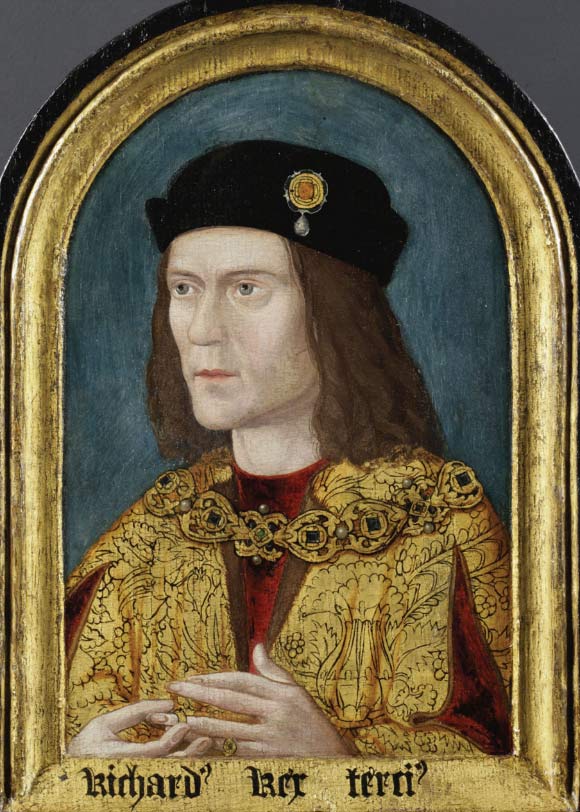A new study published in the journal Nature Communications provides overwhelming evidence that the human skeleton found under a car park in Leicester, UK, indeed represents the remains of King Richard III.

A facial reconstruction of King Richard III. Image credit: © Richard III Society.
Although Richard III only ruled for two years – from 1483 to 1485 – he stands out among his peers as one of the most famous Kings of England.
He was born in Fotheringhay Castle, Northamptonshire on 2 October 1452 – about 50 km from Leicester. He and his older brother Edward were the great-great-grandchildren of Edward III, a line of descent which was used to justify the claim to the throne by the House of York during the Wars of the Roses. The House of Lancaster was also descended from Edward III, via a different route.
After defeating an unsuccessful rebellion in October 1483, Richard III led his army to Bosworth in Leicestershire two years later to face Henry Tudor, whose somewhat tenuous claim to the throne was also through descent from Edward III.
On 22 August 1485, Richard III was killed at Bosworth Field, the last English King to die in battle, thereby bringing to an end both the Plantagenet dynasty and the Wars of the Roses. Henry Tudor was crowned King Henry VII.
Richard’s body was brought back to Leicester, publicly displayed and then given for burial to a group of Franciscan friars. An alabaster tomb monument was constructed over the grave in 1495, paid for by the new King. With the dissolution of the monasteries that friary disappeared and along with it any clear record of Richard’s grave. Stories and rumors about where Richard’s mortal remains lie or what happened to them have circulated over the ensuing centuries, but most of these have subsequently been shown to be tall tales.
In September 2012, a skeleton was excavated at the last-known resting place of Richard III.
The archaeological, osteological and radiocarbon dating evidence were all consistent with the remains being those of the king. The skeleton was that of a male aged 30 to 34 years, with severe scoliosis rendering one shoulder higher than the other, with numerous battle injuries. Modeled radiocarbon dating was also consistent with these being the remains of an individual who died in 1485.
What has been missing to date is the genetic and genealogical data, and an integrative analysis of both the genetic and non-genetic lines of evidence.
An international group of scientists headed by Dr Turi King from the University of Leicester, UK, therefore conducted ancient and modern DNA analysis, and, for the first time, a synthesis of all the evidence together, to come to an overall conclusion about the identity of the Leicester skeleton.
The analysis of all the available evidence confirms identity of Richard III to the point of 99.999 percent.

Portrait of Richard III, painted c. 1520, after a lost original, now owned by the Society of Antiquaries, London. Image credit: © Society of Antiquaries of London.
“Our paper covers all the genetic and genealogical analysis involved in the identification of the remains of skeleton from the Greyfriars site in Leicester and is the first to draw together all the strands of evidence to come to a conclusion about the identity of those remains,” Dr King said.
“Even with our highly conservative analysis, the evidence is overwhelming that these are indeed the remains of King Richard III, thereby closing an over 500 year old missing person’s case.”
The analysis of the mitochondrial DNA shows a good match between Richard III and modern female-line relatives, Michael Ibsen and Wendy Duldig.
According to the team, the male line of descent is broken at one or more points in the line between Richard III and living male-line relatives descended from Henry Somerset, 5th Duke of Beaufort.
“The combination of evidence confirms the remains as those of Richard III. Especially important is the triangulation of the maternal line descendants. The break in the Y-chromosome line is not overly surprising given the incidence of non-paternity, but does pose interesting speculative questions over succession as a result,” said study senior author Prof Kevin Schürer from the University of Leicester.
The scientists also used genetic markers to determine hair and eye color of Richard III and found that with probably blond hair and almost certainly blue eyes he looked most similar to his depiction in one of the earliest portraits of him that survived, that in the Society of Antiquaries in London.
They now plan to sequence the complete genome of Richard III to learn more about the last English king to die in battle.
_____
Turi E. King et al. 2014. Identification of the remains of King Richard III. Nature Communications 5, article number: 5631; doi: 10.1038/ncomms6631







